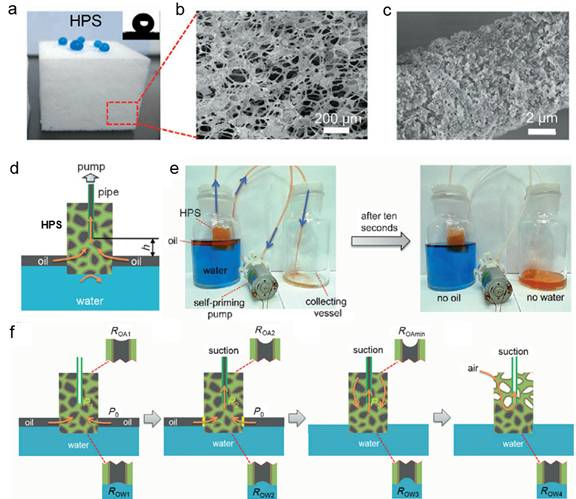Porous hydrophobic/oleophilic materials (PHOMs) have been shown to be the most promising candidates for cleaning up oil spills. However, due to their limited absorption capacity, a large quantity of PHOMs would be consumed in oil spill remediation, causing high material and transport costs. In addition, the complicated and time-consuming process of oil recovery from these sorbents is also an obstacle to their practical application.
To solve the above problems, a team led by YU Shuhong at the Hefei National Laboratory for Physical Sciences at Micrscale (HFNL), Univeristy of Science and Technology of China (USTC) provided a new model oil collection apparatus based on a simple combination of hydrophobic polymer sponge (HPS, a typical PHOM) with pipes and a self-priming pump, which can continuously and selectively collect oil in situ from a water surface with high efficiency. The results were published in Angew. Chem. -Int. Ed. (Angew. Chem.-Int. Ed. 2014, 53(14), 3612-3616) and were selected as a Hot Paper.

Figure:(a) Image of the as-synthesized HPS; inset: water contact-angle measurement of the HPS. (b, c) SEM images of the HPS with low and high magnification. (d) Oil transportation mechanisms with the HPS fully filled with oil. (e) Photographs of continuously collecting n-hexane in situ from a water surface by our proposed oil connecting apparatus. (f) Capillary pressure changes in the oil–air and oil–water interfaces of the HPS during the suction process.
The key to this design is the capillary pressures at oil-air and oil-water interfaces of HPS spontaneously regulate with the suction power applied to HPS and the unique interconnected macropores of the HPS which ensured enough passage of oil inside the sponge. The oil-air and oil-water interfaces prevents the permeation of air and water to HPS, only floating oil is absorbed by the HPS and flows along the pipes to the collecting tank, leaving the HPS consistently able to uptake the oil present. This oil collection design saves sorbents, labor, and operation time, and as a result largely decreases the cost of oil collection. In the future, for large-area oil spills, oil-collecting ships could “fish” the floating oil by pulling a large floatable oil collection net made of pips, hydrophobic polymer sponges, and pumps. This foldable oil-collection net with unlimited oil-sorption capacity, small in volume, and easy to carry, may also be used as emergency facilities for tankers and drilling platforms in case of oil leakage.
The research project is sponsored by the National Basic Research Program of China, the National Natural Science Foundation of China and the Chinese Academy of Sciences.
Link to the paper: http://onlinelibrary.wiley.com/doi/10.1002/anie.201310151/abstract
(JIN Ge, HFNL)